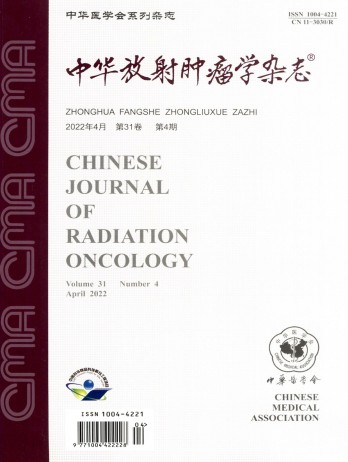Prognosis of different irradiation methods in patients with T2-3N0M0 esophageal squamous cell carcinoma
引用次数: 0
Abstract
Objective To evaluate the effect of different irradiation methods on the long-term prognosis of patients with clinical T2-3N0M0 esophageal squamous cell carcinoma, aiming to select the optimal treatment for these patients. Methods A total of 268 eligible patients admitted to our hospital from January 2007 to December 2012 were enrolled in this study. All patients were divided into the involved-field irradiation (IFI) and elective node irradiation (ENI) groups. The composition ratio, prognostic factors and adverse events were analyzed between two groups. Results The median overall survival (OS) time was 35.5 months (95%CI : 30.12-40.88) and the median disease-free survival (DFS) time was 23.5 months (95%CI: 19.00-28.00). According to the multivariate analysis results, all patients were assigned into two groups at a ratio of 1 vs.1(n=86 in each group). Multivariate analysis after propensity score matching (PSM) demonstrated that irradiation method was the independent factor of OS (P=0.038), and T stage and radiotherapy were the independent factors affecting DFS (P=0.002, 0.032). The incidence of ≥grade Ⅱ adverse events did not significantly differ between two groups (P=0.819, 0.756). However, patients with combined chemotherapy experienced more adverse events. Conclusion ENI can prolong the OS and DFS of patients with clinical T2-3N0M0 esophageal squamous cell carcinoma, and does not increase the incidence of severe adverse events. Key words: Esophageal neoplasm/involved-field irradiation; Esophageal neoplasm/elective node irradiation; Prognosis不同照射方式对T2-3N0M0型食管鳞状细胞癌患者预后的影响
目的评价不同照射方法对临床T2-3N0M0食管鳞状细胞癌患者长期预后的影响,以期为这些患者选择最佳的治疗方法。方法2007年1月至2012年12月,我院共收治268例符合条件的患者。将所有患者分为受累野照射(IFI)组和选择性淋巴结照射(ENI)组。分析两组患者的成分比例、预后因素和不良事件。结果中位总生存期(OS)为35.5个月(95%可信区间:30.12-40.88),中位无病生存期(DFS)为23.5个月(95%CI:19.00-28.00)。根据多变量分析结果,所有患者按1比1的比例分为两组(每组n=86)。倾向评分匹配(PSM)后的多因素分析表明,照射方式是OS的独立因素(P=0.038),T分期和放疗是影响DFS的独立因素,(P=0.002,0.032)。两组≥Ⅱ级不良事件的发生率无显著差异(P=0.819,0.756),联合化疗的患者出现了更多的不良事件。结论ENI可延长临床T2-3N0M0食管鳞状细胞癌患者的OS和DFS,且不增加严重不良事件的发生率。关键词:食管肿瘤/受累野照射;食管肿瘤/选择性淋巴结照射;预后
本文章由计算机程序翻译,如有差异,请以英文原文为准。
求助全文
约1分钟内获得全文
求助全文
来源期刊
自引率
0.00%
发文量
6375
期刊介绍:
The Chinese Journal of Radiation Oncology is a national academic journal sponsored by the Chinese Medical Association. It was founded in 1992 and the title was written by Chen Minzhang, the former Minister of Health. Its predecessor was the Chinese Journal of Radiation Oncology, which was founded in 1987. The journal is an authoritative journal in the field of radiation oncology in my country. It focuses on clinical tumor radiotherapy, tumor radiation physics, tumor radiation biology, and thermal therapy. Its main readers are middle and senior clinical doctors and scientific researchers. It is now a monthly journal with a large 16-page format and 80 pages of text. For many years, it has adhered to the principle of combining theory with practice and combining improvement with popularization. It now has columns such as monographs, head and neck tumors (monographs), chest tumors (monographs), abdominal tumors (monographs), physics, technology, biology (monographs), reviews, and investigations and research.

 求助内容:
求助内容: 应助结果提醒方式:
应助结果提醒方式:


